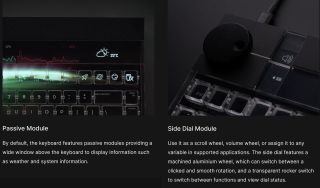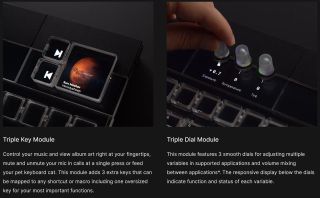New Keyboard Built From a Full-Size 1080p IPS Screen with Maglev Switches

A new keyboard which promises a sweet spot mix of touch screen adaptability and traditional tactile switches has just successfully navigated through its Kickstarter campaign. The Flux Keyboard is basically a Full HD IPS display with a perfectly fitting array of maglev key switches above it.
This arrangement allows users to customize the key displays for “any software, any language, any style.” Moreover, the keyboard overlay can offer tactile or linear keys, and there is room for up to four additional tactile modules above the F-Key row.
Breaking down this proposition piece by piece, let us first consider the underlying display. The Flux Keyboard is built upon a 1920 x 1080 pixel screen with sRGB and a max 300 nits of brightness. This touch screen runs at 60 Hz, and the makers assert that it is polled for input at 1,000 Hz and NKRO capable. The device measures 193 x 320 x 22 mm ( W x L x H ) in total, so we calculate that the screen will have a 14-inch diagonal, with quite small bezels containing the magnetic fixing aids.
As the display is a ‘soft keyboard’, it is infinitely customizable. The product designers demonstrate (in the video above) the Flux Keyboard showing many kinds of characters and languages. It can also easily be configured to show icons, hieroglyphs, emojis and more. Meanwhile, the character or icon display which will line up with the physical key overlay can feature animated backgrounds for fun or utility. An obvious way to use the Flux Keyboard is to retain a functional typing layout, with an array of keys mapped to toolbar selections in the app or game you are using.
Before we move onto the physical input apparatus which forms an important part of the Flux Keyboard, we must add that behind the screen has a dedicated quad-core microprocessor. This design feature helps make the keyboard self-contained and work across Windows, Mac, Linux and mobile operating systems (USB Type-C connection required). 8GB of onboard storage can portably save your favorite settings, macros, shortcuts, layouts etc.
Elevating the keyboard ergonomics above flat screen alternatives, the Flux Keyboard uses a perfectly matched maglev keyboard. At the current time there are two such overlays available; one tactile and one linear. Whichever you choose, they can be configured with a custom actuation point as they use hall-effect switching technology. Also important to gamers is a touted zero-debounce time, for rapid repeat actions. According to the specs, the keycaps are transparent so they don’t get in the way of the visuals beneath.
Above the keyboard deck area the display continues and can covered or used for ‘passive modules’ displaying information set in the software. However, the three physical modules are more interesting to us. One offers dial functionality, as popularized by Microsoft and Asus. Another module features a trio of knobs for quick and intuitive control of multiple variables. Lastly, for now, there is a triple key module with one large and two smaller tactile display areas using the same kind of maglev tech in the main keyboard area. Modules and key frames are hot-swappable.
In the future, the keyboard designers hope to introduce more keyboard overlay options in addition to the initial batch of ISO 85 and ANSI 84 tactile / linear maglev models. More physical modules for the top of the keyboard are also going to be developed, and there is a chance there will be a matching numpad, and layouts like ortho split.
Some of you might be intrigued, or even thrilled by the Flux Keyboard, and might expect it to feature among the best keyboards we have seen, but there are some drawbacks we must mention. For example, the first run of these keyboards is going to take several months to become available. Project backers are being told that January 2024 is targeted for delivery. General availability might lag this date by weeks or months. Another drawback is the Flux Keyboard’s retail price is US$450, which is steep, even considering its capabilities. Buyers who want an additional keyframe (tactile or linear) were asked to pay an extra $80 during the crowdfunding campaign.









